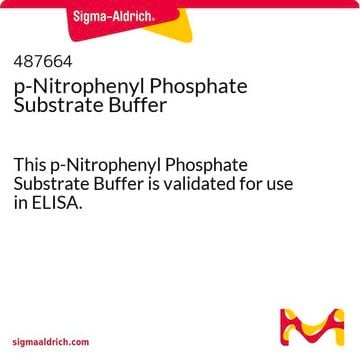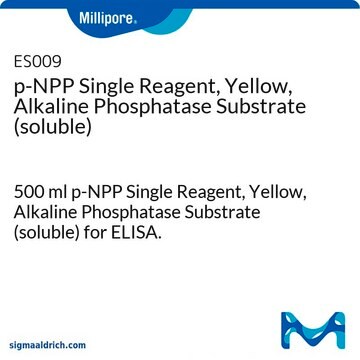487663
p-Nitrophenyl Phosphate
This p-Nitrophenyl Phosphate is validated for use in ELISA.
Synonyme(s) :
Phosphate Ester, p-Nitrophenyl Ester
Se connecterpour consulter vos tarifs contractuels et ceux de votre entreprise/organisme
About This Item
Code UNSPSC :
41116158
Nomenclature NACRES :
NA.25
Produits recommandés
Niveau de qualité
Forme
liquid
Ne contient pas
preservative
Fabricant/nom de marque
Calbiochem®
Conditions de stockage
OK to freeze
protect from light
Couleur
clearslightly yellow tint
Conditions d'expédition
ambient
Température de stockage
2-8°C
Catégories apparentées
Description générale
p-Nitrophenyl phosphate is the most common substrate for alkaline phosphatase-based ELISA assays. Hydrolysis of the phosphate ester liberates p-nitrophenol, a soluble, yellow chromogen that can be measured spectrophotometrically at 405 nm (ε = 1.83 x 104 M-1cm-1). As the reaction is linear, kinetic assays can be performed. Endpoint determinations can also be performed by stopping the reaction with strong base and measuring the absorbance at 405 nm. This p-NPP preparation is a stable, convenient, liquid concentrate in a proprietary solvent.
p-Nitrophenyl phosphate supplied as a 50X concentrate (0.19 mol/l). For use with p-NPP Substrate Buffer, Cat. No. 487664.
Excellent substrate for alkaline phosphatase-based ELISA assays. Produces yellow soluble end product that can be read at 405 nm to 410 nm. Both kinetic and endpoint determinations can be performed. Supplied as ready-to-use. A ready-to-use diluent is available separately (Cat. No. 487664).
This p-Nitrophenyl Phosphate is validated for use in ELISA.
Application
ELISA
Actions biochimiques/physiologiques
Primary Target
Substrate for alkaline phosphatase-based ELISA assays
Substrate for alkaline phosphatase-based ELISA assays
Product does not compete with ATP.
Avertissement
Toxicity: Standard Handling (A)
Forme physique
Supplied as a 50X concentrate.
Reconstitution
Discard if solution turns bright yellow or becomes turbid.
Autres remarques
Functionality check performed on the final product in ELISA.
Suggested procedure for use of p-NPP in alkaline phosphatase-based ELISAs:
1. Prepare 1X p-NPP Substrate Solution: To 39 parts dH2O add 1 part 50X p-NPP Concentrate and 10 parts p-NPP Substrate Buffer (Cat. No. 487664). Mix well and store protected from light. This diluted reagent is suitable for up to 10 h after preparation.
Note: Cat. No. 487664 is an AMP (2-amino-2-methyl-1-propanol)-based buffer. Other buffers, e.g. diethanolamine (DEA)-based and 2-amino-2-methyl-1,3-propanediol (AMPD)-based, may also be employed.
2. Complete all required incubations with antibodies and alkaline phosphatase-labeled probes.
3. Wash plate wells at least 4 times with Tris-buffered saline (TBS) containing 0.1% Tween®-20 detergent. DO NOT USE PHOSPHATE BUFFERS; inorganic phosphate is a potent inhibitor of alkaline phosphatase.
4. After the final wash, shake and blot all residual buffer from the wells.
5. Add 100 µl of 1X p-NPP Substrate Solution (prepared in Step 2) to each well and incubate for 15-60 min. (If a kinetic study is desired, readings at 405 nm may be taken at intermediate intervals).
[Note: Optimal incubation times may vary depending on the amount of enzyme present. If color develops too quickly, dilution of the probe, antibody, or alkaline phosphatase-labeled reagent may be required.]
6. Stop the reaction by adding 100 µl 1 N NaOH.
7. Read absorbance at 405 nm.
Note: Variations in time, reagent volumes, and temperature may require further standardization by the user.
Suggested procedure for use of p-NPP in alkaline phosphatase-based ELISAs:
1. Prepare 1X p-NPP Substrate Solution: To 39 parts dH2O add 1 part 50X p-NPP Concentrate and 10 parts p-NPP Substrate Buffer (Cat. No. 487664). Mix well and store protected from light. This diluted reagent is suitable for up to 10 h after preparation.
Note: Cat. No. 487664 is an AMP (2-amino-2-methyl-1-propanol)-based buffer. Other buffers, e.g. diethanolamine (DEA)-based and 2-amino-2-methyl-1,3-propanediol (AMPD)-based, may also be employed.
2. Complete all required incubations with antibodies and alkaline phosphatase-labeled probes.
3. Wash plate wells at least 4 times with Tris-buffered saline (TBS) containing 0.1% Tween®-20 detergent. DO NOT USE PHOSPHATE BUFFERS; inorganic phosphate is a potent inhibitor of alkaline phosphatase.
4. After the final wash, shake and blot all residual buffer from the wells.
5. Add 100 µl of 1X p-NPP Substrate Solution (prepared in Step 2) to each well and incubate for 15-60 min. (If a kinetic study is desired, readings at 405 nm may be taken at intermediate intervals).
[Note: Optimal incubation times may vary depending on the amount of enzyme present. If color develops too quickly, dilution of the probe, antibody, or alkaline phosphatase-labeled reagent may be required.]
6. Stop the reaction by adding 100 µl 1 N NaOH.
7. Read absorbance at 405 nm.
Note: Variations in time, reagent volumes, and temperature may require further standardization by the user.
Informations légales
CALBIOCHEM is a registered trademark of Merck KGaA, Darmstadt, Germany
TWEEN is a registered trademark of Croda International PLC
Code de la classe de stockage
12 - Non Combustible Liquids
Classe de danger pour l'eau (WGK)
WGK 3
Point d'éclair (°F)
Not applicable
Point d'éclair (°C)
Not applicable
Certificats d'analyse (COA)
Recherchez un Certificats d'analyse (COA) en saisissant le numéro de lot du produit. Les numéros de lot figurent sur l'étiquette du produit après les mots "Lot" ou "Batch".
Déjà en possession de ce produit ?
Retrouvez la documentation relative aux produits que vous avez récemment achetés dans la Bibliothèque de documents.
Les clients ont également consulté
Notre équipe de scientifiques dispose d'une expérience dans tous les secteurs de la recherche, notamment en sciences de la vie, science des matériaux, synthèse chimique, chromatographie, analyse et dans de nombreux autres domaines..
Contacter notre Service technique








